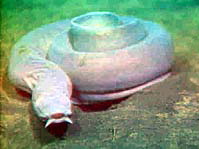Hagfish
|
|
| Hagfish | ||||||||||||
|---|---|---|---|---|---|---|---|---|---|---|---|---|
 Pacific Hagfish resting on bottom 280 m down off Oregon coast | ||||||||||||
| Scientific classification | ||||||||||||
| ||||||||||||
| Genera | ||||||||||||
A hagfish is any of several marine chordates of the class Myxini, also known as Hyperotreti. They are long, vermiform, and exude a sticky slime (from which the typical species Myxine glutinosa was named). They tie themselves in knots and scrape the slime off themselves to clean themselves.
Instead of vertically articulating jaws like Gnathostomata (Vertebrates with jaws), they have a pair of horizontally moving structures with toothlike projections for pulling off food. They enter both living and dead fish, feeding on the insides. Marine worms are also prey. They tend to be quite common in their range, sometimes becoming a nuisance to fishermen by devouring the catch before it can be pulled to the surface.
Hagfish average about a half-meter (18 inches) in length; Eptatretus carlhubbsi is the largest known, with a specimen recorded at 116 cm, while Myxine kuoi and Myxine pequenoi seem to reach no more than 18 cm.
There has been long discussion in scientific literature about the hagfish being non-vertebrate. Recent molecular biology analyses however (see references) indisputably classify hagfish as a vertebrate.
If a Hagfish wishes to disengage from its current prey, they form a knot with their body and slide it towards the mouth. The knot provides something to press against in order to pull the mouth off. This is a unique trait.
Hagfish are eaten in Japan, and their skin is made into "eel leather" in Korea.
In recent years hagfish have become of special interest for genetic analysis investigating the relationships among chordates. It has also recently been discovered that the mucus excreted by the hagfish is unique in that it includes strong, threadlike fibres similar to spider silk. Research continues into potential uses for this or a similar synthetic gel or of the included fibres. Some possibilities include new biodegradable polymers, space-filling gels, and as a means of stopping blood flow in accident victims and surgery patients.
About 64 species are known, in 5 genera. A number of the species have only been recently discovered, living at depths of several hundred metres. Some of the species are listed here:
Genus Eptatretus:
- Inshore Hagfish, Eptatretus burgeri
- Black Hagfish, Eptatretus deani
- Gulf Hagfish, Eptatretus springeri
- Pacific Hagfish, Eptatretus stoutii
Genus Myxine:
- Cape Hagfish, Myxine capensis
- Hagfish (or Atlantic Hagfish), Myxine glutinosa
- White-headed Hagfish, Myxine ios
See also
Reference
- J.M. Jørgensen, J.P. Lomholt, R.E. Weber and H. Malte (eds.), The biology of hagfishes (London: Chapman & Hall, 1997)
- Delarbre et al., 2002 Molecular Phylogenetics and Evolution, 22(2):184-192
- Bondareva and Schmidt, 2003 Molecular Biology and Evolution, 20(11):1932-1939
External link
- FishBase entry for Myxinidae (http://www.fishbase.org/Summary/FamilySummary.cfm?ID=2)fr:Myxine
